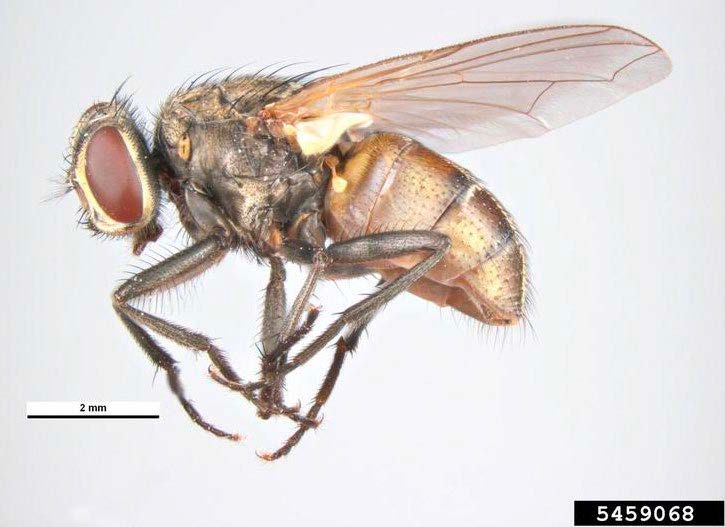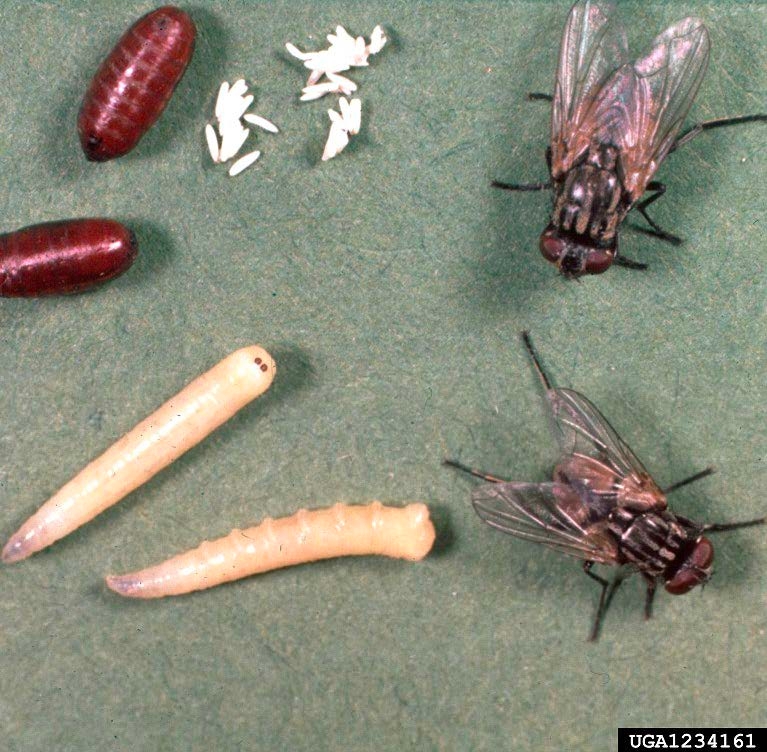House Fly
ID
ENTO-137NP (ENTO-416NP)
Description
Adult house flies are medium-sized flies about 6 mm (0.25 inch) long. They are grayish-black in color, with four dark bands running the length of the thorax and conspicuous bristles on the body (Fig. 1). The abdomen is usually yellowish or gray with a dark midline. The large eyes are reddish-brown and there are silvery patches between the eyes on the face. There are two pairs of wings, but the hind wings are small and modified for balance during flight. Adults often cluster in the sun on the warm sides of buildings, outcroppings, fences, and other prominent structures. House fly larvae (maggots) are found in dung, garbage, and rotting organic materials. Homeowners may find house fly maggots in garbage cans that have been left uncovered and not emptied regularly, or in improperly stored food.

Life Cycle
House flies have a complete life cycle consisting of egg, larval, pupal, and adult stages (Fig. 2). House fly eggs are elongated, yellowish-white ovals about 1 mm (0.04 inch) long. Adult females can lay up to 100 eggs in a cluster on a food source. The eggs hatch quickly into yellowish-white larvae (maggots) with a tapered head and no head capsule. The body is elongated and broadest at the end of the blunt, flattened abdomen. Maggots have bands of tiny, flat, teeth-like spines encircling the body to help them move through their food. Mature maggots measure about 10 mm (0.4 inch). Larvae grow and molt three times before pupating in dry areas surrounding their food source. Larval development progresses rapidly at warmer temperatures. Pupae resemble elongated oval capsules with a tough brown skin. Adult flies emerge to mate and lay eggs. Multiple generations occur each year, limited primarily by cold temperatures and the availability of suitable food sources. They overwinter as pupae.

Damage
House flies are members of a group of flies collectively known as “filth flies.” Adult house flies feed on liquids from rotting garbage, carrion, and dung. Adults can transfer the disease organisms responsible for dysentery, salmonella, and other food-borne illnesses from filth to fresh foods intended for human consumption if they have access to them. Adult house flies do not bite humans or animals, but most people find their presence very unwelcomed.
Habitat and Distribution
Cosmopolitan; house flies can be found everywhere in association with human habitation as well as in the wild.
Control
Sanitation is extremely important in controlling filth flies. Remove garbage and animal waste in a timely manner using garbage bags and a garbage can with a tight-sealing lid. Dead animals should be disposed of properly soon after death. Maggots infesting garbage cans can be killed cheaply and organically with boiling water. Limit the entry of flies into homes by installing good window and door screens with a tight fit. Inside the home, use a fly swatter or an aerosol spray to kill adult flies. Do not contaminate foods or eating utensils with insecticides. Outside the home, do not allow garbage to accumulate and promptly clean up any spills. Use insecticides with residual formulations to treat the walls adjacent to dumpsters or other fly breeding sites. Light traps may be useful outdoors, but they may also attract flies from a broader area.
Revised
Theresa A. Dellinger, January 23, 2021.
Virginia Cooperative Extension materials are available for public use, reprint, or citation without further permission, provided the use includes credit to the author and to Virginia Cooperative Extension, Virginia Tech, and Virginia State University.
Virginia Cooperative Extension is a partnership of Virginia Tech, Virginia State University, the U.S. Department of Agriculture (USDA), and local governments, and is an equal opportunity employer. For the full non-discrimination statement, please visit ext.vt.edu/accessibility.
Publication Date
March 1, 2021



